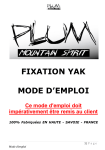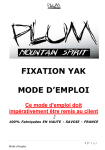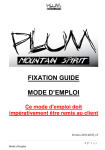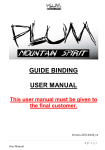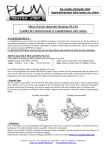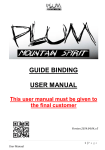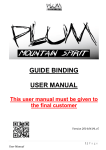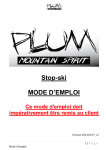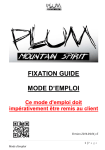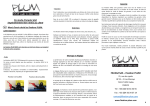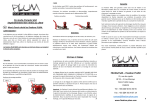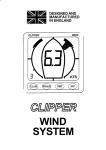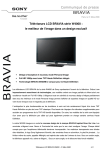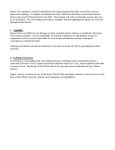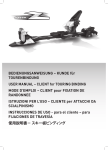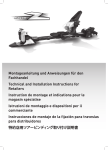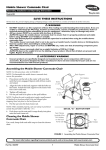Download Mode Emploi YAK 2013-2014_V4 - ENG
Transcript
FREERIDE SERIES YAK USER MANUAL This user manual must be given to the final customer. 100% MADE IN HAUTE - SAVOIE – France 1|P a g e User Manual 4 3 1 2 1- Toe Pin 2- Crampon slot 3- Locker 4- Leash 5- T25 screw 5 2|P a g e User Manual 17 13 11 7 10 14 6 8 9 12 6- Heel piece adjustment screw 7- Adjustment Rail 8- Mz release adjustment screw 9- My release adjustment screw 10- Ski pole slot 11- Heel riser 12- Housing 13- Heel pins 14- Heel piece base plate 17- Heel pad 3|P a g e User Manual 15- Boot heel inserts 16- Boot tip insert 4|P a g e User Manual All the PLUM staff thanks you for having chosen a PLUM YAKBinding. This lightweight yet stiff binding will offer you accuracy, reliability and pleasure in your alpine and touring skiing. IMPORTANT NOTICE: These bindings do not meet the requirements of the ISO 13992 standards. Designated to experienced skiers For your own safety, the full and careful reading of this user manual is very important before using our product for the first time. It is very important to follow the instructions hereafter while using PLUM YAKbindings. The YAKbindings have been designed in order to be used with insert technology touring ski boots. WARNING: The release values can be highly affected by inserts and/or boot soles highly worn out. You should never adjust the release values of your bindings by yourself. These settings must meet the ISO 11088 requirements. It takes into account your weight / height, your age, your boot sole length, such as the type of skiing you are practicing. Make sure your bindings are adjusted by a specialized dealer, who will check these with the required device. The YAKbindings are designed to be mounted only on skis. They are not adapted to be mounted on anything different such as snowboards, monoskis, etc. Any mounting/adjustment not made by a certified dealer is the customer’s responsibility and automatically cancels the warranty. UserManual Manual User 5|P a g e Safety Instructions The ski and the off-piste skiing contain inevitable dangers for every skier. Your binding PLUM is a part of the unity ski, binding and shoe. It is not possible to plan in every situation if the binding is going to release or not. It does not still release and in all the circumstances, what can cause serious injuries with unpredictable consequences. When you go skiing, no guarantee of safety against any accident of the skier can be given. It is true that bindings with releasing system reduce considerably the risk of wounds at the level of legs and feet, but do not cancel it completely. They do not reduce the risk of wounds on other parts of the body. For all of your mountain trips, ensure maximal safe conditions and verify the following: • Select a trip in accordance with your skills, always skiing in a controlled fashion according to your skills and your physical condition. Never overestimate your skills. • Always check weather and snow conditions before leaving. • Always follow information and signs in zone you are skiing. • Do not go touring or skiing if you feel tired or in poor physical condition. • Do not go touring or skiing if you are taking medication, or under the effects of alcohol or any other addictive product. • Always use the leashes provided with the bindings, by fastening them around each leg. These leashes are meant to hold the skis back in case of binding release, and let the ski slide free, so as not to lose them or have them become an uncontrolled danger for anybody else. • Always protect your skis and bindings while travelling (in a ski bag for example), in order to protect them from dust, sand, road salt or any other abrasive substances. • Always double-check your bindings and your equipment before going skiing/ touring. Make sure no foreign material 6|P a g e User Manual (dirt, gravel...) are found within the mechanism, both on toe and heelpieces. Aforementioned foreign material can affect the release mechanism of the binding if present in either toe or heelpieces. If you have any doubt about the reliability of your equipment, get it checked by a specialized dealer. • Never make any modifications to your bindings by yourself. Any inappropriate use or modification can interfere with the release capacity of the bindings. • The YAK binding should be mounted directly on the ski. Nothing should be placed between the ski and the bindings. • Get your bindings serviced at least once a year, more likely at the beginning of the season. (Global functioning and release values) 7|P a g e User Manual Mounting and Setting It is very important to respect the hole patterns and the foreand-aft alignment of the toe and heel piece. Consequently, it is highly recommended to have the bindings mounted by a specialized dealer equipped with a drilling jig. Regarding the drilling parameters, it is highly recommended to follow the ski manufacturer’s instructions in order to obtain the minimum level of retention in the ski. The release setting must be done according your own experience and your personal specificities (age, type of skier, weight, etc.) The setting done by a specialized dealer IS ONLY ACCURATE WHEN DONE WITH THE EXACT SAME BOOT AS THE ONE USED FOR ADJUSMTENT and usage cannot be directly transferred to a different boot. If the boots are replaced, the release setting should be recalibrated. The fastening of the heel adjustment screws (6) must be checked before the first use, and then a couple of times a year. WARNING: These bindings do not meet the requirements of the ISO 8364 standard. Check with the ski manufacturer the mounting compatibility related to the holes pattern. WARNING: Check the toe piece (5) screws locking such as the heel adjustment screws after the first mounting and a couple of times a year. 8|P a g e User Manual Using Instructions LENGTH ADJUSTMENT: To adjust the length of the heelpieces, the two screws must be loosened (6) with the provided T25 tool. Slide the heelpiece to desired length, using the marks on the side of the rail (5), and then fasten the adjustment screws tightly (6). Gap between the heelpiece and the boot A 4mm gap must be respected between the boot insert and the heelpiece housing. This 4mm gap is set with the green spacer provided with the bindings. Gap between the boot sole and the heel pad (17) A 1mm gap must be respected between the boot sole and the heel pad. This gap is set with a piece of paper used as a spacer. 9|P a g e User Manual TOE PIECE The YAK bindings are equipped with a locking system on each toe piece. This locker can be in two positions: either WALK (locked) or SKI (Unlocked). When the toe piece is stepped-into, it is automatically in ski mode. - SKI Mode (Unlocked - downhill): To switch the locker into ski mode, push the black locker forward until it reaches an almost horizontal position. The word « SKI » is now visible on the lever. The SKI mode means the clamp system of the toe piece is unlocked. Hence, in such a position, the binding retains a release capacity, and your boot will be released in case of a fall. This SKI mode position must be kept during any descent. Moreover, in such a situation, the boot must be stepped into the heelpiece. 10 | P a g e User Manual - WALK Mode (Locked - Uphill): To switch the toe piece into WALK Mode; pull the black locker towards the boot until it is placed almost perpendicular to the ski. The SKI word should be hidden and the WALK word should now visible. The WALK mode means the clamp system of the toe piece is locked. Hence, in such a position, no release is possible, and your boot will not be released in case of a fall. This WALK mode position is to be used during an ascent, never during a descent. Moreover, while in WALK mode, the boot must not be stepped in the heelpiece. 11 | P a g e User Manual HEEL PIECE The heelpiece rotates into 4 different positions, 3 uphill positions 1 downhill: LOW position (uphill) - SKI mode (descent) MEDIUM position (uphill) HIGH position (uphill) LOWER position: In the LOW position, the heelpiece is turned in order to let the heel move freely and to step on the heel pad. In such a position, the toe piece must be set in WALK Mode. MEDIUM Position In the MEDIUM position, the heelpiece is turned in order to let the heel move freely and to step on the heelpiece top plate. In such a position, the toe piece must be set in WALK Mode. 12 | P a g e User Manual HIGH Position In the HIGH position, the heelpiece is turned in order to let the heel move freely and to step on the top tower of the top plate. In such a position, the toe piece must be set in WALK Mode. To switch from one position to the next, follow this method: Elevate your boot so as not to be in contact with the heelpiece. Place the tip of your pole in one of the holes of the tower (10), with either right or left hand. Twist your pole until you reach the desired position. 13 | P a g e User Manual SKI Position (descent) In SKI Mode, the heelpiece is rotated in order to have the pins facing towards the front of the ski. These pins are the ones into which the boot steps. In such a position, the toe piece must be in SKI Mode. 14 | P a g e User Manual HOW TO STEP IN WALK MODE? Make sure the toe piece clamp (1) is open. If closed, push the front lever (3) down, until the toe clamp opens. Make sure the heelpieces are in one of the three uphill positions. Check nothing is present under the toe piece or the ski and clean any foreign material from your boot sole. Find out which out the four following methods suits you: - Method 1: place the toe of your boot over toe piece, keeping the heel a little bit elevated, pushing down until the two front pins (1) fasten into the boot tip insert (16). - Method 2: place the toe of your boot over the toe piece, keeping the heel a little bit elevated, and then rotate your boot in order to fit one of the front inserts (1) in the boot tip insert (16). Then push boot down flat until the toe piece fastens and both inserts (1) perfectly fit the boot tip inserts (16). - Method 3: This method is a lot easier if you are equipped with Quick-Step technology inserts. Place the toe of your boot onto the toe piece horizontally. Then push down, until the toe piece fastens and both inserts (1) fit into the boot tip inserts (16). - Method 4: Make sure your heelpiece is in low position. Bring your boot heel against the heelpiece keeping the tip a little bit elevated. Then push down onto toe piece with the toe of the boot until the clamp fastens and both inserts (1) fit perfectly in the boot tip inserts (16). WARNING: When stepped in, pull up the front lever (3) to place it in WALK mode. Then tie on the safety leashes. 15 | P a g e User Manual HOW TO STEP IN SKI MODE? # If your boot is out of the binding At first, rotate the heelpieces in order to place them in SKI Mode. Then step-in according to one of the 4 procedures described in the previous chapter. Push your heel down until the boot heel inserts (15) are locked in the rear pins (13). WARNING: Once stepped into the heelpiece you must place the front lever (3) in SKI mode. And tie on your safety leashes. # If you are already in WALK Mode Rotate the heelpiece to the SKI mode (descent), then, push your heel down until the boot heel inserts (15) are locked in the rear pins (13). WARNING: Once stepped in the heelpiece you must place the front lever (3) in SKI mode. And tie on your safety leashes. HOW TO STEP OUT THE BINDINGS: # From the WALK Mode, push down with either your hand or your ski pole on the front lever (3), until the toe piece opens. The front pins (1) will then retract from the boot tip inserts (16). # From the SKI Mode, push down with either your hand or your ski pole on the front lever (3), until the toe piece opens. The front pins (1) will then retract from the boot tip inserts (16). It is now possible to elevate the toe of your boot and rotate to the right and left in order to remove the boot from the heel pins. # after a fall: Falling might place you in a situation where higher stress is placed on the bindings. Push hard on the front 16 | P a g e User Manual lever (3) towards the ski until the toe piece opens. The front pins (1) will then retract from the boot tip inserts (16). It is now possible to elevate the toe of your boot and rotate it right and the left in order to remove the boot from the heel pins. HOW TO USE A SKI CRAMPON To mount a ski crampon, place them perpendicularly to the ski, slide the crampon axis into the toe piece crampon slot (2), until it clicks in. Make sure the crampon can rotate freely in the slot. For removal, rotate crampon to a 90° angle then slide to either side out of the slot (2). Stepping out of your bindings is not required to either put on or take off your crampons. Putting on the crampons or taking them off is possible in the uphill position. Kneeling down is required to slide the crampon under the boot, which should be heel-up during the procedure. The crampon slot (2) on the toe piece is compatible with any crampons for the brands Dynafit or ATK. Make sure your crampons are the appropriate width for your skis. A little room must be left between the interior of the crampon and the ski edge. Contact between crampons and the ski edge must be avoided to prevent ski damage. Crampons can be used on hard/iced snow, though not on rock and/or dense, thick ice, nor on any hard surface. WARNING: Use of these bindings should only be undertaken after reading and full comprehension of this user manual. If clarity is required, please ask a specialized dealer before using. Any inappropriate use may generate an accident and/or severe injuries. 17 | P a g e User Manual WARRANTY: YAK bindings are under warranty for any material or manufacturing defect for a period of two years from the purchase date. FELISAZ SAS will fix or replace (according to models available) any binding with any recognized defect. This warranty only covers users whose bindings have been mounted by a specialized dealer, and with a proof of purchase. Damage attributable to bad mounting, usage mistakes, abusive use or neglect cannot be covered under warranty (e.g. unprotected transportation/storage, not following the user manual). Regular wear, an accident, a product modification or for any aspect/colour modification are also not covered by warranty. FELISAZ SAS cannot be considered as responsible for any accessory or indirect damage. A number of countries or states do not agree on warranty restriction or responsibility, hence some of the aforementioned restrictions may not apply in some cases. Each distributor is responsible for all the sales in its territory; hence you are invited to contact your local distributor. For any inquiries, please bring the product and proof of purchase to the closest specialized dealer. 18 | P a g e User Manual www.Fixation-plum.com FELISAZ SAS Fixations PLUM RCS Annecy 381 823 509 Z.I Les Marvays 21 rue des Cyprès - BP 22 74311 Thyez Cedex FRANCE Tel : +33 (0)4 50 34 58 59 Fax : +33 (0)4 50 34 57 14 Email: [email protected] 19 | P a g e User Manual



















